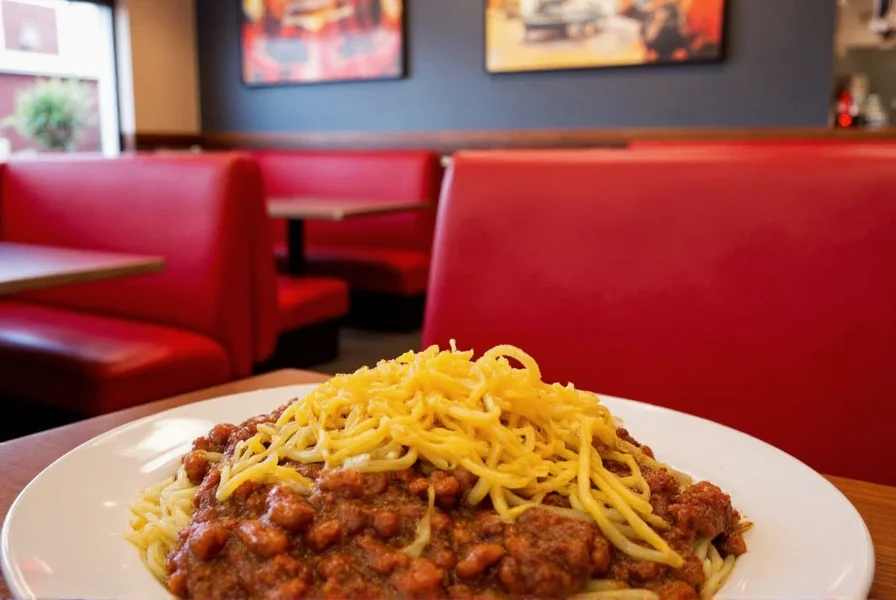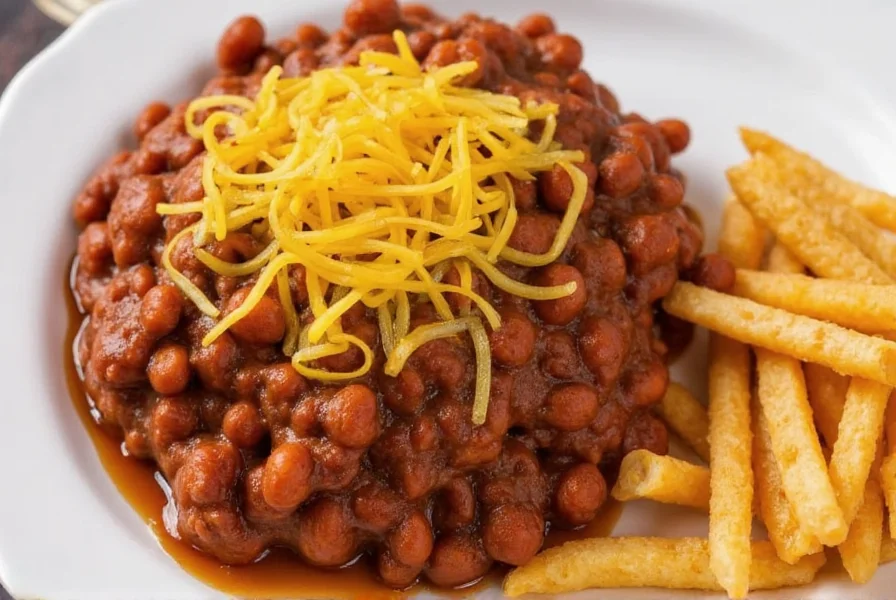When searching for the best Cincinnati chili, you're not looking for traditional Tex-Mex chili con carne but rather a distinctive Mediterranean-spiced meat sauce served over spaghetti. This unique culinary tradition has defined Cincinnati's food scene since the 1920s, with specific establishments earning legendary status through consistent quality and authentic preparation.
What Makes Cincinnati Chili Unique
Cincinnati chili breaks nearly every "rule" of conventional chili. Instead of being served as a standalone bowl, it's always layered over spaghetti, topped with cheese, and ordered using a specific "way" system. The signature flavor profile features unexpected spices like cinnamon, allspice, and cocoa powder, creating a sweet-savory complexity that divides chili purists but delights locals.
The distinctive preparation method involves simmering ground beef in a rich broth of tomato paste and spices for hours, resulting in a thinner consistency than traditional chili. This allows it to properly coat spaghetti while maintaining its unique flavor profile.
How Cincinnati Chili Establishments Are Evaluated
When determining the best Cincinnati chili spots, several key factors matter more than simple taste preferences:
| Evaluation Criteria | Why It Matters | Top Performers |
|---|---|---|
| Spice Balance | The perfect harmony of sweet and savory notes defines authentic Cincinnati chili | Skyline, Gold Star |
| Meat Quality | Freshness and texture of ground beef affects overall mouthfeel | Dixie Chili, Please Mr. Chow |
| Consistency | Reliable quality across locations and visits demonstrates proper preparation | Skyline, LaRosa's |
| Regional Authenticity | Adherence to traditional Cincinnati preparation methods | All major chains |
Top Cincinnati Chili Establishments
Skyline Chili
As the most recognizable Cincinnati chili brand with over 130 locations, Skyline represents the gold standard of Cincinnati chili. Founded in 1949 by Greek immigrants Nicholas and Tom Kiradjieff, Skyline perfected the distinctive spice blend that defines the regional specialty. Their 3-way (chili over spaghetti with cheese) remains the most ordered item, though chili cheese dogs have become increasingly popular.
What sets Skyline apart is their remarkable consistency across locations. Whether you're dining at their original Over-the-Rhine location or a suburban outpost, the flavor profile remains unmistakably Skyline. Their secret spice blend, reportedly containing over 15 ingredients including cocoa and cinnamon, creates the sweet-savory complexity that defines Cincinnati chili.

Gold Star Chili
Often considered Skyline's primary competitor, Gold Star Chili offers a slightly different interpretation of Cincinnati's signature dish. Founded in 1965, Gold Star has cultivated a devoted following with their "so good" slogan and distinctive preparation method. Many locals claim Gold Star's chili has a richer tomato flavor and slightly different spice balance compared to Skyline.
Gold Star's menu innovation has helped them stand out, particularly with their 5-way potato (chili, cheese, onions, beans, and mustard over a baked potato). Their commitment to fresh preparation—cooking chili in small batches throughout the day—contributes to their reputation for quality.
LaRosa's Pizza
While primarily known for pizza, LaRosa's serves arguably the city's best complementary chili. Founded in 1954, LaRosa's developed their own distinctive chili recipe that many consider superior to dedicated chili establishments. Their chili features a smoother texture and more pronounced Mediterranean spice notes.
Unlike the major chili chains, LaRosa's prepares their chili in copper kettles using a closely guarded recipe. This attention to traditional preparation methods results in a more complex flavor profile that appeals to both chili enthusiasts and skeptics.
Independent Favorites
While the major chains dominate Cincinnati's chili landscape, several independent establishments have earned devoted followings:
- Dixie Chili - Known for their "Dixie 5-way" with a spicier profile and higher meat-to-sauce ratio
- Please Mr. Chow - Modern take on Cincinnati chili with craft beer pairings and creative variations
- Kybecca - Upscale restaurant offering gourmet interpretations of Cincinnati chili
How to Order Cincinnati Chili Like a Local
Understanding Cincinnati's "way" system is essential for navigating chili menus. The terminology can confuse visitors, but locals use these terms effortlessly:
- 3-way - Chili over spaghetti with shredded cheddar cheese
- 4-way - 3-way plus your choice of beans or onions
- 5-way - 3-way plus both beans and onions
- Splinter - Chili cheese dog
- Cones - Spaghetti topped with chili, served in a paper cone
Most locals start with a 3-way and customize from there. Adding oyster crackers is considered essential by many purists, while hot sauce remains controversial among traditionalists.
The History Behind Cincinnati Chili
Cincinnati chili's origins trace back to the 1920s when Macedonian and Greek immigrants adapted their native meat sauces to American ingredients. The Kiradjieff brothers, who founded Empress Chili (precursor to Skyline), created the distinctive spice blend that would define the regional specialty.
Unlike traditional chili, which evolved from Texas cowboys' meat stews, Cincinnati chili reflects Mediterranean culinary traditions. The addition of chocolate and cinnamon likely came from Greek and Turkish spice blends, while serving over spaghetti reflects Italian immigrant influence in early 20th century Cincinnati.
By the 1940s, chili parlors had become Cincinnati institutions, with the distinctive red booths and chrome decor becoming synonymous with the experience. The post-war boom saw these small establishments expand into the regional chains that dominate today's market.
Finding Authentic Cincinnati Chili Beyond the City
While Cincinnati remains the epicenter of this culinary tradition, several establishments outside the region attempt authentic preparations. When searching for Cincinnati chili elsewhere, look for these authenticity markers:
- Proper "way" menu terminology
- Spaghetti as the base (not beans or cornbread)
- Distinctive sweet-savory spice profile
- Thin consistency (not thick like traditional chili)
Many imitators miss key elements, particularly the unique spice blend and proper serving method. The most authentic experiences outside Cincinnati typically come from franchises of the major chains rather than independent interpretations.
Frequently Asked Questions About Cincinnati Chili
What's the difference between Skyline and Gold Star chili?
Skyline features a slightly sweeter profile with more pronounced cinnamon notes, while Gold Star has a richer tomato flavor and different spice balance. Skyline maintains remarkable consistency across locations, whereas Gold Star cooks chili in smaller batches throughout the day, potentially creating subtle variations. Both use the same basic "way" ordering system but Gold Star is known for innovations like the 5-way potato.
Why is Cincinnati chili served over spaghetti?
This unique serving method originated from early 20th century Cincinnati's immigrant communities. Greek and Macedonian immigrants adapted their native meat sauces to include spaghetti, which was becoming popular among Italian immigrants in the city. The combination created a distinctive dish that differentiated Cincinnati chili from traditional chili con carne. The spaghetti provides a neutral base that allows the complex spice profile to shine while creating a complete meal.
Does authentic Cincinnati chili contain chocolate?
While chocolate isn't typically listed as a direct ingredient, many authentic Cincinnati chili recipes include unsweetened cocoa powder as part of the spice blend. This contributes to the dish's distinctive deep, rich flavor without making it taste sweet. The cocoa helps balance the acidity of the tomatoes and enhances the overall complexity of the spice profile. Some establishments use chocolate indirectly through certain brands of commercial chili powder that contain cocoa.
What's the proper way to eat Cincinnati chili?
Locals typically start with a 3-way (chili over spaghetti with cheese) and customize from there. Essential elements include using oyster crackers to add texture and stirring them into the chili. Many purists avoid adding hot sauce, considering it disrespectful to the carefully balanced spice profile. The proper technique involves mixing the cheese thoroughly into the hot chili so it melts completely, then incorporating the oyster crackers for added crunch. Most Cincinnatians eat chili with a spoon rather than a fork.
Can you make authentic Cincinnati chili at home?
Yes, but achieving authentic flavor requires attention to specific details. Key elements include using a combination of ground beef and broth rather than just meat, incorporating Mediterranean spices like cinnamon and allspice, and including tomato paste for richness. The chili should have a thinner consistency than traditional chili to properly coat spaghetti. Many home cooks find success by simmering the chili for several hours to develop complex flavors. Authentic recipes typically call for 1-2 tablespoons of unsweetened cocoa powder as part of the spice blend.











 浙公网安备
33010002000092号
浙公网安备
33010002000092号 浙B2-20120091-4
浙B2-20120091-4